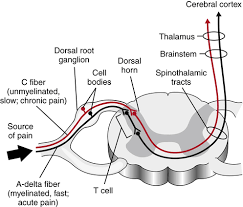 Pain fibers, known as nociceptors, are specialized sensory neurons responsible for detecting noxious stimuli and transmitting pain signals to the central nervous system.
Pain fibers, known as nociceptors, are specialized sensory neurons responsible for detecting noxious stimuli and transmitting pain signals to the central nervous system.
These fibers can be classified based on their diameter and degree of myelination.
Two main types: A-delta (Aδ) fibers and C fibers.
A-delta fibers are thinly myelinated and have a relatively fast conduction velocity.
A-delta fibers Are primarily responsible for transmitting sharp, acute pain sensations (pricking” or stabbing pains).
These fibers respond to intense mechanical and thermal stimuli, providing a rapid warning signal that prompts immediate withdrawal from the harmful stimulus.
C fibers, are unmyelinated and have a slower conduction velocity.
C fibers are associated with the transmission of dull, aching, and burning pain, often referred to as “slow” pain.
C fibers are polymodal, responding to a variety of noxious stimuli, including mechanical, thermal, and chemical stimuli.
This type of pain is typically more prolonged and can be associated with tissue damage and inflammation.
Nociceptors express various ion channels and receptors that are crucial for their function.
Transient receptor potential (TRP) channels such as TRPV1, TRPM8, and TRPA1 play significant roles in detecting thermal and chemical stimuli.
Additionally, voltage-gated sodium and calcium channels are essential for the generation and propagation of action potentials in these fibers.
